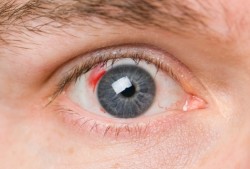Almost every person during his life came across a small hemorrhage in the eye, which could occur after a long seating for a computer monitor or physical injury. Such cases are not dangerous, but there are much more serious intraocular hematomas, which appear to complex diseases.
The appearance of blood inside the eye is a consequence of the rupture of the walls of the vessels arising from mechanical exposure, or a signal on the progressive pathology of the internal organs. At the same time, such a state is accompanied by a number of symptoms: headache, the fall of visual acuity, the appearance of the cutting feeling, the blurring of the image, as well «Mushhek» before your eyes. All these manifestations indicate a certain medical problem, to identify that can be identified after the diagnosis of the body. Our site will tell about the most common causes, types and methods of treating such a disease.
Types of eye hemorrhage

Modern medical practice allocates several types of eye hemorrhage. Consider the more detailed characteristics and features of the appearance.
Hemorrhage in the front chamber - Gifema. With this type of disease, the blood of a burst vessel falls into the space between the iris and the cornea. Externally, bleeding takes the form of uniform scarching formation with clear contours. Characteristically spreading blood stains through the whole eyeball, if a person is in a horizontal position. Either sedimentation of stains per bottom, when hemorrhage occurs when the body is vertical. In most cases, with the hyphem, the vision does not deteriorate, unless the blood zone will close the whole pupil. And the scattering process of bunches occurs quite quickly, often occupying 3-4 days from the date of education.
Extravasate in the zone of the vitreous body - hemophthalm. This type of bleeding happens due to damage to the shell of visual organs. Externally, it looks like a homogeneous education immediately behind the lens, as a rule, brown. There are also two types of outpouring: complete, which threatens the loss of vision, as well as a partial, provoking a slight drop in the sharpness of the function. Such a disease can manifest itself after severe complications, for example, the atrophy of the eyeball, dystrophy or retinal detachment. Recognize hemophthalm by such signs as: sharp light flashes, «Mushkush», The appearance of dark fixed spots before your eyes.
Hemorrhage in the retina eye - vascular pathology, which manifests sufficiently weakly, while absolutely not clear to what extent there was damage to the tissue. This will help identify only an ophthalmologist survey. It is manifested by such a disease near the symptoms, among which it is allocated: the absence of a sharp visual picture before the eyes, the appearance «Mushhek» or black «Grid». Disposable outpouring does not threaten serious consequences, but its regular occurrence is fraught with complete loss of vision.
The main causes of eye hemorrhage

The priority action that needs to be done if you diagnosed one of the signs of intraocular outpouring is the definition of its type and causes. Depending on the result, you can understand how much time you have to assist. In any case, with the pathology of this species, it is advisable to immediately contact a specialist. However, we first consider which treatment methods are used in the hemorrhages of all types.
Hemorrhology in the vitreous body. This is the most severe case of bleeding, so it is necessary to immediately apply for medical care and lie on the stationary hospitalization. With timely treatment with ophthalmologists with the involvement of specialized equipment there is a chance to preserve the visual function. Remember the earlier you react - the higher the chances of restoration.
Bleeding in the eye. In case you noticed a scarlet stain in the cavity of the orphanage - immediately consult a doctor, since such an outpouring in the field of the eyelids and around the eye is a signal about the fracture of the skull base. If the displacements did not happen, such pathology is usually eliminated without surgical intervention. In any case, it is advisable to protect yourself from such damage, avoiding harsh, intense heads, injuries and falls, as well as taking vitamin C, which softens the arterial walls.
Extravasate in the front eye chamber. Specific treatment in the hyphem will not need. Undoubtedly, it is still worth consulting a doctor, but you will not have to hospitalize you. Ophthalmologists prescribe in this case a drop of 3% of potassium iodide, which need to be pouring within 7 days. However, if bleeding does not pass after 10 days, it is necessary to remove the clots by means of surgical intervention. Tightening with treatment may entail serious complications, for example, glaucoma, uveit, cataract, etc. It is also not recommended to take anti-inflammatory non-steroidal preparations of any shape and anticoagulant, since their action can slow down the blood coagulation process.

Bleeding in retina. One-time hemorrhage to the eye does not require urgent hospitalization. With such a manifestation of an ophthalmologist, as a rule, assigns the means of the vessel-blowing and hemostatic action, prescribes a full rest for the eyes and the common peace of the patient. However, it is necessary to immediately turn to a specialist if you have signs of extensive hemorrhage.
In conclusion, it is necessary to once again emphasize the importance of timely hospitalization. Remember that the eye is a very fragile, but an important body of the human body and treat it on their own forces, if you have no profile education. Trust health care specialist, eliminating the risk of aggravation problem.









